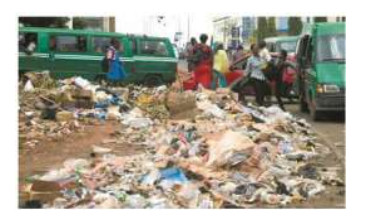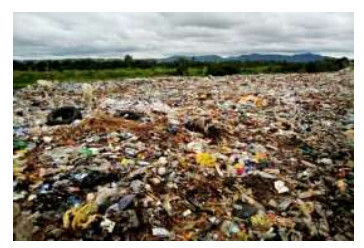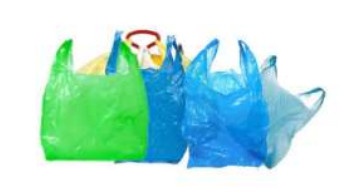Polyethylene bags (known as Nylon bags in Nigeria) are a common household name on the lips of everyone in Nigeria. Its versatile purposes, convenience, durability, flexibility and affordability has earned it as a part of day to day life necessity. People continue to devise countless ways Polyethylene bags can be utilised and be of immense benefit to them. This has placed a huge demand on the production of polyethylene bags. However, due to its chemical structure, Polyethylene bags do not bio-degrade readily, which led to accumulation of waste Polyethylene bags in the environment. This accumulation does not only deteriorate the aesthetic panorama but also has an indirect negative impact on health, as individual health cannot be separated from their environment. Unfortunately, majority do not understand the implications, and the concerned agencies are nonchalant to threat posed by accumulation of Polyethylene bags in the environment. Therefore, this paper seeks to reveal the imminent environmental consequences of accumulation of polyethylene waste bags in Nigeria and the way out.
1.
Introduction
According to Braun D et al. [1,2], the discovery of "macromolecules" by Hermann Staudinger in the early nineteens, pave way for the development of synthetic polymeric materials. Due to their high molecular weight, polymeric materials are known to possess some quality attributes such as mechanical and technical properties [3,4] which are not observed in other substances like metal and iron. For instance, against the shortcoming of iron and metal, the chemical nature of polymer has made it resistible to water and micro-organisms attack [5,6], which has enhanced the durability of polymeric materials. However, these distinct polymer properties have been inimical to the bio-degradation of polymer waste leading to the accumulation of polymer waste in the environment [6,7]. The accumulation of this polymer waste is considered a huge threat to healthy living and environment [8].
Polyethylene bags (known as Nylon bags in Nigeria) among other polymeric compounds were developed in the 1970s [9,10], and since then, it has gained wide acceptance among the buyers and sellers. Special features such as its versatility, affordability, availability, and minimal cost to produce among other factors are reasons for its wide usage, as Spokas KA [11] reported that around 500 billion plastic bags are used every year worldwide. The case is not far from Nigeria, Anichebe E [12] revealed that Nigeria generates more than 32 million metric tonnes of waste annually, which plastic waste is amount to 2.5 million tons [13]. Nigeria is rated as the ninth in the world for plastic pollution especially in marine pollution, and mismanagement of plastic waste [7].
Due to its availability and affordability, people discard polyethylene bags at a slight opportunity, neglecting the other option of reuse. One of the reasons for this act is that they know, they can easily acquire one when next they visit any supermart, or simply walk up to any vendor, which their request will be gladly granted as a means of winning their patronage. Though recycling is much emphasised, recycling Low-Density Polyethylene (LDPE) and Linear-Low Density Polyethylene (LLDPE) bags are considered not cost-effective, as it is cheap, and the feasibility of leaching toxic chemicals at the point of recycling is also major hindrance [12]. This is why Polyethylene bags are much saturated in Nigeria's environment.
Odior et al. [14] revealed that, Nigeria is Africa's largest importer of plastics in primary forms, as production of Linear-Low Density Polyethylene bag happened to be a major source of income for small-medium business opportunities. This may be difficult for government to completely do away with polyethylene bags, as it is a means of livelihood to some. However, the health and the environmental impacts of Polyethylene bags outweigh all the benefits [11,15]. Polyethylene bags, especially, Linear-Low Density Polyethylene bag is generously utilised in Nigeria without a second thought of what will be the response of environment to this overloading of Polyethylene waste.
Therefore, this paper seeks to discourse the imminent danger of generous uses of Polyethylene bags in Nigeria, and its environmental implications.
2.
Uses of Polyethylene bags in Nigeria
According to Dumbili E et al. [7], the use of plastic bags with other single-use plastic products such as takeaway food packs, spoons, cups and straws is a daily adventure in Nigeria.
Polyethylene bags (Nylon bags) are generously used for many purposes in Nigeria, such as packaging nylon (LDPE bag) for books; small electronics appliances (both LDPE and LLDPE), food items (majorly LLDPE bag), commodity etcetera. It is used as waste collection nylon (LDPE bags) in many local hospitals, organisations and homes. While low-income earners children and rural dwellers used it as school bags, many households and food vendors use Linear-Low Density Polyethylene bag as a wrapper for solid meal, complimentary gifts in some supermarts and boutiques. Some customers even request extra nylon (LDPE and LLDPE bags), which are generously granted without a thought of the impact of that single nylon on the environment.
Apart from the prevalent uses of polyethylene bags (known as Nylon bags) in various supermart and shop outlets, one of the most predominant usages is in domestic affairs, especially, kitchen apartments. Nigeria being blessed with many tribes [17], has many local dishes, which cut across different regions. Most of these local delicacies are majorly in form of solid, as our forefathers, whose major occupations such as farming, blacksmith, fishing etc., required energy. They believed that solid meals could supply the energy needed to carry out their day-to-day activities, so most local meals are solid. Some of these local dishes were formerly prepared in specialised leaves before cooking (such as Moinmoin, Okpa), or wrapped with leaves when is done (such as Eba, Apu, Tuwo, pounded yam, Amala, Kukure etc.).
With the advent of technology and the discovery of Polyethylene bags, these special leaves previously used for cooking and wrapping of solid meals, have been substituted with polyethylene bags [18]. Even, the likes of modern vitamins-fortified solid meals such as Semolina, Wheat are now usually wrapped with polyethylene bags after cooking, even when the meal is still hot. This is a common practice at major homes, food vendors and cafeterias. Although, research is ongoing to determine the health negative impact of Polyethylene bags, but the discovery of plastic bisphenol-A (BPA) residue in human urine [19], has attested to the fact that same can occur with polyethylene bags. alami T and Ogbe A [16,20] buttressed this fact by predicting high tendency of chemical leaching of Polyethylene bags (or Polyethylene additives) into the food as a result of heat application in the process of wrapping hot solid meal (such as Semo, Amala, Apu and Tuwo Shinkafa), and cooking of Moinmoin, Okpa (a solid meal derived from beans pudding) with polyethylene bags. This has a grave consequence as terminal diseases such as cancer and renal failure have been traced to ingestion of this harmful chemical via food [19]. Unfortunately, most people that patronised these nylon-wrapped foods are those that cannot adequately take care of the health consequence of consuming nylon-wrapped food due to financial constraints.
Also, in most local canteen, low-class families, and rural areas, firewood is often a major source of cooking. Waste Polyethylene bags are commonly used to ignite the fire to the firewood, in some cases, waste polyethylene bags are burnt concurrently with firewood, in order to speed up the rate of combustion. In the process of cooking, some may inhale smoke containing polyethylene chemicals, while some smoke may be dissolved into the meal that is on fire. On long exposure, this may have negative effect on the eyes, as well as on the environment [21].
3.
Physico-chemical properties of Polyethylene
The chemical composition of polymer distinguishes it from other materials as polymer contains a repeated unit of monomers or copolymers [1,3]. According to Ewelele RO ([22], the properties of polymer is not independent of their molecular weight. Since same polymer under different degree of polymerisation exhibit different properties, it will be wise to examine different molecular weight of polyethylene to predict their polymeric behaviours.
The need to improve more on HDPE properties such as flexibility gave birth to LLDPE. Linear Low-Density Polyethylene (LLDPE) is produced by copolymerization of ethylene with relatively small amounts of 1-alkene at low temperature and pressure [23]. According to Wikipedia [24], the actual polymerization process can be done either in solution phase or in gas phase reactors. Usually, octene is the comonomer in solution phase while butene and hexene are copolymerized with ethylene in a gas phase reactor. The result of copolymerization process generates short branches along the linear polyethylene chain.
According to Okamura T et al. [23,25,26], Polyethylene (•CH2―CH2―) x was first synthesized on an industrial scale in 1939. This was done under high pressure of about 1,000–3,000 atm and at temperatures ranging from 80℃ to 300℃. A free radical polymerisation mechanism was employed in the presence of benzoyl peroxide as initiator. The final product resulted in Low-Density Polyethylene (LDPE).
The limited application of Low-Density polyethylene due to the high number of branches formed, as a result of intermolecular and intramolecular chain transfer during polymerization, pave way for the introduction of High-density polyethylene [27]. High-density polyethylene (HDPE) is usually prepared at low pressure at about 70℃ in the presence of a special catalyst (Ziegler-Natta catalyst) [28].
Due to the high crystallinity, Polyethylene bags made from HDPE are durable, and not easily torn. Therefore, it can be re-used many times before finally disposed. Waste from HDPE bag is not so rampant, as it can outlast so many bags produced from LLDPE and LDPE. Recycling of HDPE bag is also feasible. A polyethylene bag made from LLDPE is usually referred to as a single used Polyethylene bag. Because of their flexibility, and availability, it is usually used once, it is affordable, easy to produce, and very cheap. Most waste Polyethylene bag in Nigeria is made from LLDPE, therefore, it constitutes the most misused of all Polyethylene bags.
4.
Environmental Implication of Polyethylene bag (Nylon bags)
Improper disposal is one of the major environmental challenges of polyethylene bags in Nigeria [7]. It upsets the delicate balance of sanitation, majorly in the sub and urban area because of their high patronage to products that comes with Polyethylene bags. Several reports [6,7,31] revealed heaps of waste Polyethylene bags (Nylon bags) scattering throughout the major cities of Nigeria. For instance, Anunonwu CO [32] reported a heap of waste nylon bags in Owerri, the capital city of Imo State. The same trend was also noticed in Benin city, where improper disposal of waste in Nylon bag was prevalent on the major streets [33].
The Federal Capital Territory is not exonerated from this, as many dump areas are plagued with waste nylon bags flying all around, especially in a slum area surrounding the Federal Capital. This improper disposal may be seen as one of the contributing factors to flooding, as [34] revealed that the accumulation of polyethylene bags can block the drainage system, thereby causing water to go in wrong direction. Dumbili E et al. [7,35] further revealed that household sewerage system can be jeopardised as a result of throwing away wastewater with waste polyethylene bags used for wrapping solid meals, a practice which is prevalent among middle and low-class families.
Blocked drainage causes stagnant water, which provides site for mosquito breeding, as the survey [36] revealed that malaria remains the foremost public health problem among pregnant women and infants under five (5) years in Nigeria. WHO [37] further approximately estimated that 57 million cases of malaria are reported, and nearly 100,000 malaria-related deaths occur each year. This cost the Federal government 40% of total GDP in prevention, treatment and cost of labours [15,36].
The presence of LDPE in soil was recently reported to show the most negative effect among other plastic types reducing the growth and quantitative phytochemicals in plants [40,41].
Recently, the community solid waste, which includes waste polyethylene bags has been utilised in landfilling. All polymers including polyethylene bags decompose very slowly, due to limited availability of oxygen and humidity [8,21].. The product yielded CH4 (methane), H2O and CO2 (carbon dioxide) with biomass. Methane is one of the gasses that cause Greenhouse effect (depletion of ozone layer, thereby allowing the penetration of direct sunlight). Skin cancer and skin diseases are the direct consequence of greenhouse effect. Also, [9] revealed that domestic animals fed on plants from this contaminated soil risk being choked or death.
Incineration of household solid waste is a common practice in Nigeria, especially, in towns and semi-urban areas where a waste collection system is not functioning or under-functioning
However, North EJ [21] revealed that incineration of polymeric materials such as polyethylene bags could be harmful to the health and environment, as its residue may consist of chemicals, Volatile Organic Compound (VOCs). These can trigger greenhouse effect, asthma in asthmatic patients, and upset the delicate balance of nervous system.
Marine pollution is also a major recipient of land plastic bags pollution. Studies had revealed the tendency of waste plastic bags migrating to the sea [7,12]. This has grave consequences on aquatic habitat, also on the consumers of such sea animals. Nigeria is considered the ninth nation with largest plastic waste pollution of marine [7]. Marine waste plastic pollution has been considered as the source of microplastic in rainwater.
5.
Conclusion
Though, the advent of Polyethylene bags brought about convenience and affordability, however, the health and the environmental impacts of Polyethylene bags outweigh all the benefits [11,15]. While the use of Polyethylene bags cannot be suddenly abhorred, however, there is an urgent need for adequate measures to address the imminent environmental consequence of Polyethylene bags. This measure should be focus on promoting the idea of reducing; reuse and recycling Polyethylene bags. The government at different strata should champion the course of promoting awareness of the implications of Polyethylene bags to the environment.
Research focussing on the copolymerisation of the natural product with a polymer to make polymer biodegradable should be encouraged through all the institutions and research institutes.
Also, the Federal Government through the designated policymakers should legislate and regulate the amount of Polyethylene bags produced in the country, this will encourage the habit of 'reduce and reuse' Polyethylene bags in the country. Nigeria government can emulate various measure taking by neighbouring countries (such as Rwanda and Kenya) to eliminate the use of Polyethylene bags and replace with biodegradable ones (such as paper bag).
Conflict of interest
The authors unanimously declare that this paper is free from any conflict of interest.










 DownLoad:
DownLoad:





